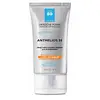What's inside
What's inside
 Key Ingredients
Key Ingredients

 Benefits
Benefits

 Concerns
Concerns

 Ingredients Side-by-side
Ingredients Side-by-side

Butyl Methoxydibenzoylmethane 3%
UV AbsorberHomosalate 10%
Skin ConditioningEthylhexyl Salicylate 5%
UV AbsorberOctocrylene 5%
UV AbsorberBenzophenone-3 6%
UV AbsorberDimethicone
EmollientC12-15 Alkyl Benzoate
AntimicrobialTalc
AbrasiveDiisopropyl Sebacate
EmollientSilica
AbrasiveSilica Silylate
EmollientGlycerin
HumectantTrimethylsiloxysilicate
EmollientDimethicone Crosspolymer
Emulsion StabilisingWater
Skin ConditioningDiethylhexyl Syringylidenemalonate
Skin ProtectingCassia Alata Leaf Extract
AstringentMaltodextrin
AbsorbentButyl Methoxydibenzoylmethane 3%, Homosalate 10%, Ethylhexyl Salicylate 5%, Octocrylene 5%, Benzophenone-3 6%, Dimethicone, C12-15 Alkyl Benzoate, Talc, Diisopropyl Sebacate, Silica, Silica Silylate, Glycerin, Trimethylsiloxysilicate, Dimethicone Crosspolymer, Water, Diethylhexyl Syringylidenemalonate, Cassia Alata Leaf Extract, Maltodextrin
Cyclopentasiloxane
EmollientDimethicone Crosspolymer
Emulsion StabilisingEthylhexyl Methoxycinnamate
UV AbsorberTitanium Dioxide
Cosmetic ColorantZinc Oxide
Cosmetic ColorantCoco-Caprylate/Caprate
EmollientPolyglyceryl-3 Polyricinoleate
EmulsifyingIsostearic Acid
CleansingBis-Ethylhexyloxyphenol Methoxyphenyl Triazine
Skin ConditioningDimethicone
EmollientTalc
AbrasiveIron Oxides
Methylene Bis-Benzotriazolyl Tetramethylbutylphenol
UV FilterThermus Thermophillus Ferment
Skin ConditioningGlycerin
HumectantPhenoxyethanol
PreservativeMelanin
Skin ProtectingSodium Levulinate
Skin ConditioningPotassium Sorbate
PreservativeParfum
MaskingCyclopentasiloxane, Dimethicone Crosspolymer, Ethylhexyl Methoxycinnamate, Titanium Dioxide, Zinc Oxide, Coco-Caprylate/Caprate, Polyglyceryl-3 Polyricinoleate, Isostearic Acid, Bis-Ethylhexyloxyphenol Methoxyphenyl Triazine, Dimethicone, Talc, Iron Oxides, Methylene Bis-Benzotriazolyl Tetramethylbutylphenol, Thermus Thermophillus Ferment, Glycerin, Phenoxyethanol, Melanin, Sodium Levulinate, Potassium Sorbate, Parfum
Ingredients Explained
These ingredients are found in both products.
Ingredients higher up in an ingredient list are typically present in a larger amount.
Dimethicone is a type of synthetic silicone created from natural materials such as quartz.
What it does:
Dimethicone comes in different viscosities:
Depending on the viscosity, dimethicone has different properties.
Ingredients lists don't always show which type is used, so we recommend reaching out to the brand if you have questions about the viscosity.
This ingredient is unlikely to cause irritation because it does not get absorbed into skin. However, people with silicone allergies should be careful about using this ingredient.
Note: Dimethicone may contribute to pilling. This is because it is not oil or water soluble, so pilling may occur when layered with products. When mixed with heavy oils in a formula, the outcome is also quite greasy.
Learn more about DimethiconeDimethicone Crosspolymer is a silicone created by modifying dimethicone with hydrocarbon side chains. Due to its large size, it does not penetrate skin. It is considered non-occlusive.
Dimethicone Crosspolymer is used to stabilize and thicken products. It also helps give products a silky feel.
Glycerin is already naturally found in your skin. It helps moisturize and protect your skin.
A study from 2016 found glycerin to be more effective as a humectant than AHAs and hyaluronic acid.
As a humectant, it helps the skin stay hydrated by pulling moisture to your skin. The low molecular weight of glycerin allows it to pull moisture into the deeper layers of your skin.
Hydrated skin improves your skin barrier; Your skin barrier helps protect against irritants and bacteria.
Glycerin has also been found to have antimicrobial and antiviral properties. Due to these properties, glycerin is often used in wound and burn treatments.
In cosmetics, glycerin is usually derived from plants such as soybean or palm. However, it can also be sourced from animals, such as tallow or animal fat.
This ingredient is organic, colorless, odorless, and non-toxic.
Glycerin is the name for this ingredient in American English. British English uses Glycerol/Glycerine.
Learn more about GlycerinTalc is a clay mineral. It helps absorb moisture and improve the texture of products. Like other types of clay, Talc can have a slight exfoliating effect on skin. Talc can be added to increase the volume of products.
Some Baby powders are made by combining talc with corn starch. The word "talc" comes from Latin and originates from Arabic. Talc is a mineral commonly found throughout the world.
If you have any concerns about using talc, we recommend checking out the FDA's official page.
Learn more about Talc